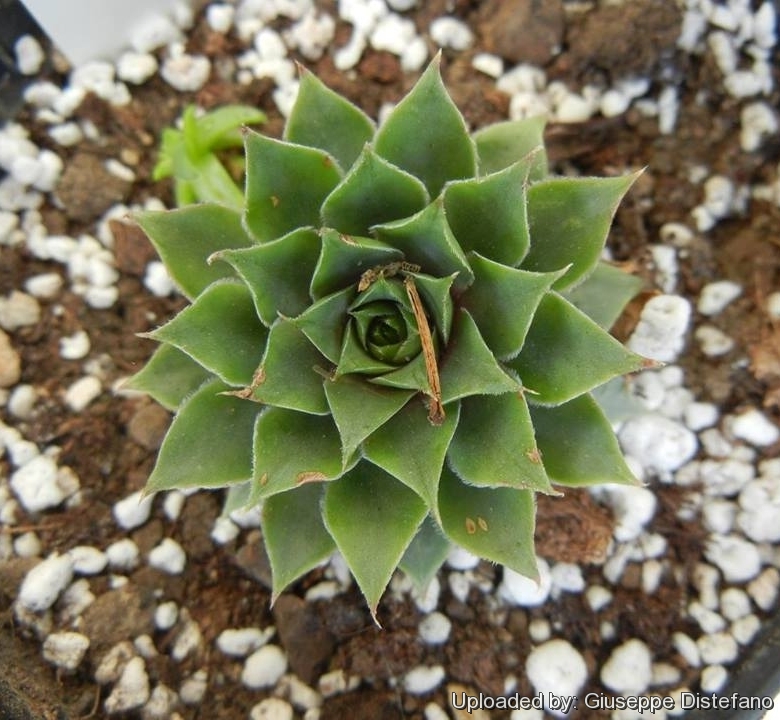Accepted Scientific Name: Sempervivum wulfenii Hoppe ex Mert. & W.D.J.Koch
Deutschl. Fl. (Röhling), ed. 3. 3: 386 1831 Mert. & W.D.J.Koch

Sempervivum globiferum (Sempervivum wulfenii) Photo by: Giuseppe Distefano
Origin and Habitat: Sempervivum wulfeniiSN|32153]]SN|32153]] is found across most of the central-eastern Alps ( Austria, Italy, Slovenia and Switzerland).
Altidude range: 1500-2700 metres above sea level.
Habitat and ecology: The plant occurs on rocky terrain, typically on bedrock on neutral to acid siliceous soil, although it readily adapts to alkaline soil, in situations particularly arid due to the intense insulation to which they are submitted in summer.
Synonyms:
See all synonyms of Sempervivum wulfenii
back
Accepted name in llifle Database:Sempervivum wulfenii Hoppe ex Mert. & W.D.J.KochDeutschl. Fl. (Röhling), ed. 3. 3: 386 1831Synonymy: 2
Accepted name in llifle Database:Sempervivum wulfenii subs. juvanii (Strgar) Favarger & J.Parn.Bot. J. Linn. Soc. 103(3): 217 (1990)Synonymy: 2
back
Description: Wulfen's House-leek (Sempervivum wulfeniiSN|19333]]SN|32153]]) is a succulent, perennial, stoloniferous, yellow-flowered, smooth-leaved sempervivum of the Alps, whose tapering green leaves are bluish-green — unlike those of the dark green-reddish large-flowered House-leek. It has a stocky, light green flowering stem, crowned with star-shaped flowers of lemon yellow. Out of flower it is similar to S. tectorum var glaucum, but easily distinguished: the rosette leaves are less numerous, and the inner leaves are tight, mostly rounded or conical, and more grayish with a light purple-red base.
Derivation of specific name: The species was named in honor of Franz Xaver von Wulfen an Austrian Jesuit and eminent botanist from the late 1700s.
Rosettes: 3-6(rarely to 10) cm across, open, similar to those of Sempervivum tectorumSN|32153]]SN|19333]] ssp. glaucum but central leaves closed to form a central bud. Few offsets are produced on long, stout, woody stolons to 10 cm. The plant is monocarpic, the individual rosette blooms only once, then dies, replaced by the close ones.
Leaves: Persistent, alternate and succulent, sessile, oblong to spathulate, cuspidate, 20-30(-40) mm long and 10-15 mm wide, usually hairless except for the marginal hairs, glaucous grey-green with a purple-red base and darker tips. Margins slightly bent inward toward the tip, highly glandular, in the upper part often bare.
Inflorescences (compact terminal cymes): Flower-stem 15-25(-30) cm, covered with hairy lanceolate leaves, which are slightly recurved at the tips, pale green at times tinged with red and about 3,5 cm long.
Flowers: 20-30 mm across, funnel-shaped to stellate 11-16-merous. Sepals pointed often purple 6 long and united together for about 2 mm. Petals, linear and pointed, 12-15(-18) mm long, 1-2 mm wide, lemon-yellow with a purple dot at the base, externally covered by thick glandular hairs. Filaments purple to red-purple, occasionally purplish green, anthers yellow. Stylus about 2 mm long pale lemon yellow. Nectar-glands, small squarish.
Blooming season: The plant flowers Summer (July—August).
Fruits: The fruits are follicles containing several tiny seeds.
Chromosome number: 2n = 36.
Bibliography: Major references and further lectures
1) Gillian Price, “Alpine Flowers” Cicerone Press Limited, 14 April 2014
2) Reichenbach, “Icones florae Germanicae et Helveticae” 23: t. 69 (1896-1899)
3) Praeger, “An account of the Sempervivum group”, 91 (1932)
4) Huxley. “Mountain flowers”. pl. 232 (1967)
5) Grey-Wilson & Blarney, “Alpine flowers of Britain and Europe”. 75 (1979).
6) James Cullen “The European Garden Flora Flowering Plants: A Manual for the Identification of Plants Cultivated in Europe, Both Out-of-Doors and Under Glass” Cambridge University Press, 11 August 2011
7) T. G. Tutin “Flora Europaea: Psilotaceae to Platanaceae” Cambridge University Press, 22 April 1993
8) “Quarterly Bulletin of the Alpine Garden Society”, Volume 36 The Society, 1968
9) Fritz Köhlein “Color Encyclopedia of Garden Plants and Habitats” Timber Press, 1994
10) Urs Eggli “Illustrated Handbook of Succulent Plants: Crassulaceae: Crassulaceae” Springer Science & Business Media, 01 January 2003
Cultivation and Propagation: Sempervivum wulfeniiSN|32153]]SN|32153]] is a small, evergreen perennial succulent that grow in rosette forming mats up to 30 cm (or more) in diameter, occasionally cultivated in rock gardens. It is quite slow to grow, difficult in cultivation, and needs winter protection. It is shy in producing flowers.
Soil: Although it grows mainly on acidic substrata, it does not seem fussy about conditions in the garden. Require a well drained succulent soil mix. Outdoors it will spread itself through narrow locations between rockery stones. It does not prefer rich loamy soil; gritty dirt with pea gravel suits it.
Watering: It takes little water & could rot if watered too often. During the growing season, the plants are watered and allowed to dry slightly before watering again. Although they can take a great deal of drought, they seem to do better with regular (but moderated) watering. During the winter months, plants are watered very little.
Exposition: It need full sun to light shade and tolerates shade, but a sunny spot is nicest, though in warmer climates it needs protection from too much sun because it is not very heat tolerant.
Frost Tolerance: Hardy at least to -12°C (or less).
Remarks: After the plant blooms and sets seed it will die, but there will be many offsets to take its place.
Uses: It is choicest species for the rock-garden and borders, it can be used for edgings, lines and panels in the flower garden, and naturalized on walls, ruins, or any position where the Common Houseleek thrives.
Propagation: Is very easily propagated by division of larger clumps or by offsets.










